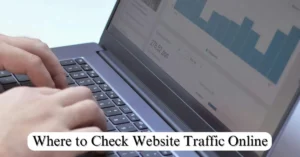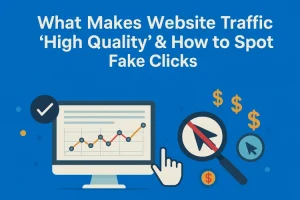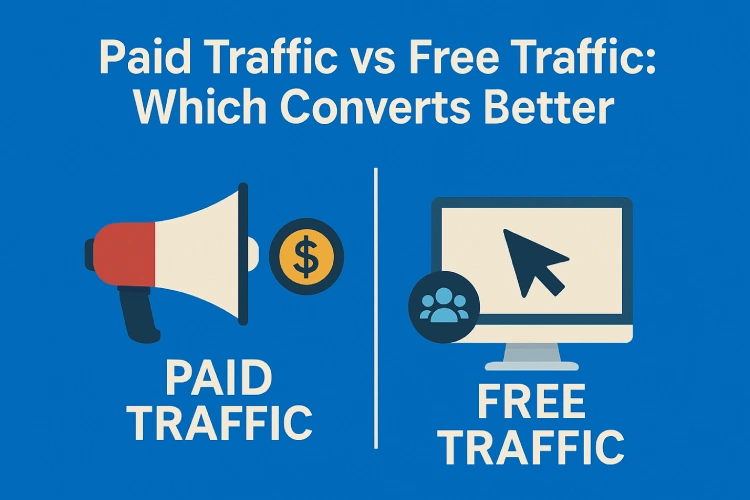
Let’s say you finally launched your website. Maybe it’s an online store, a service, or even a blog. You’ve spent hours (or days) getting it to look just right. But here’s the problem: No one’s visiting it.
- First, you check your analytics – barely any traffic.
- Then, you Google your site – it’s nowhere to be found.
- You even post on social media – nothing.
Now you're wondering: “Should I run ads and pay for visitors?”, or, “Should I try to get traffic for free using proper SEO and content marketing?”
I’ve been in the SEO world for years, and here’s the short answer for 2025: Paid traffic gives you faster results. On the other hand, free traffic takes time but builds long-term value.
In this blog, I’m going to break it all down — super simple. I’ll explain the difference between paid and free traffic, when to use each, and which one converts better in 2025.
I’ll even show you real stats, examples, and what’s working right now.
Key Takeaways
- Paid traffic gives fast results – You pay for ads and get visitors quickly, perfect for new product launches or short-term offers.
- Free (organic) traffic takes time but lasts longer – SEO, blog posts, and social media bring visitors without paying per click, and the results grow over time.
- Paid traffic costs more – You pay every time someone clicks your ad. It can be expensive if not managed well.
- Free traffic builds trust – People often trust content they find on Google or YouTube more than ads.
- Both work best together – Many businesses use paid ads to test what works and then use SEO and content to grow long-term.
- Choose based on your goal – Want quick sales? Go for paid. Want to build a strong brand over time? Focus on free traffic.
Before knowing which converts better between paid traffic vs free traffic, let me share in detail about these two so that you can get a clear picture.
What is Paid Traffic?
Paid traffic is when you pay to bring people to your website. Usually, you’re paying for every click on an ad — that’s called PPC or pay-per-click.
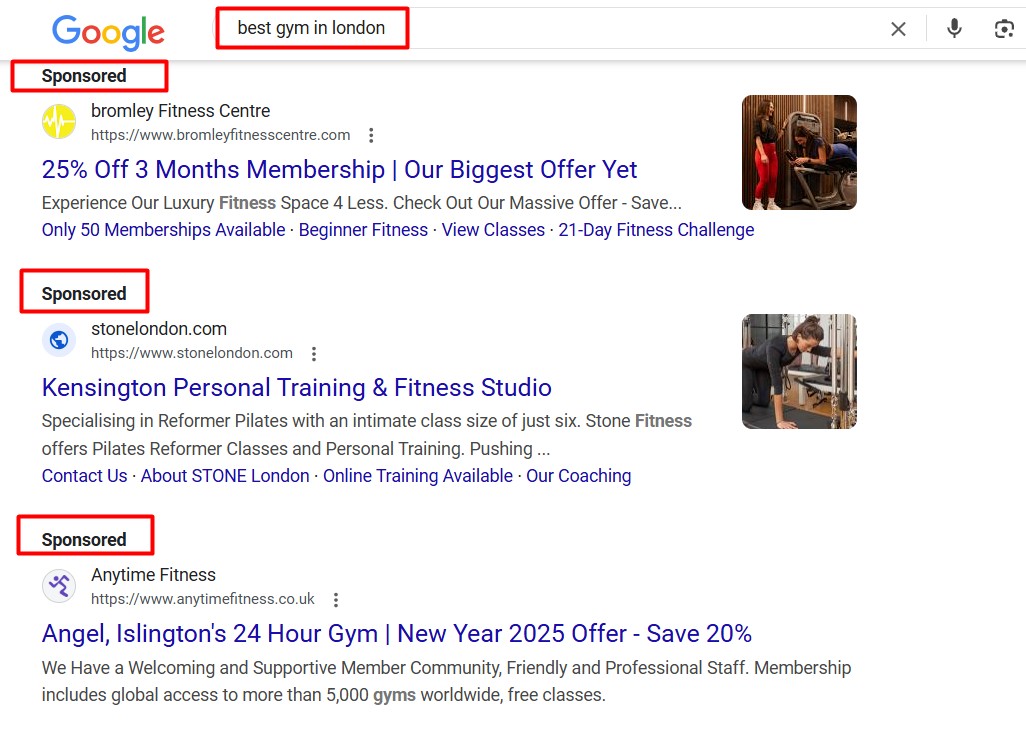
So, imagine you run a Google ad. Someone types “best gym in London,” sees your ad, clicks it, and lands on your site. Boom, that’s paid traffic.
You’re basically buying attention.
It’s like renting space on the internet. You pay, they visit. You stop paying, they stop coming.

Examples of Paid Traffic Sources in 2025
Now in 2025, the ad game’s evolved a bit. Here's where people are spending money to get clicks:
- Google Search Ads – These show at the top of search results. Still one of the best for “intent-based” traffic. Here, people are actively searching for something.
- Facebook & Instagram Ads – Super useful if you know your audience’s interests, age, or behaviors. Great for visuals, stories, or carousel posts.
- TikTok Spark Ads – These are short video ads that blend in with TikTok. They're massive right now, especially for younger audiences and trending products.
- YouTube Shorts Ads – Basically TikTok-style ads but on YouTube. Short, catchy, and visual. Huge engagement.
- Native Ads (Taboola, Outbrain) – These show up as recommended articles on big websites. They look like real content but are actually ads. Good for blogs or listicles.
Each platform has its own style, but the core idea is the same: You pay, they send people to your site.
Benefits of Paid Traffic
Let me tell you why people love paid traffic:
✅ Fast results
You can literally turn on an ad and start getting clicks the same day. No waiting months to rank on Google. This is gold when launching something new or testing a product.
✅ Precise targeting
Want to reach 30-year-old parents in Manchester who like fitness and follow gym pages? Easy. You can dial in your audience by age, gender, location, interests, and even behaviors. It’s like laser-focused marketing.
✅ A/B testing made easy
You can create two versions of your ad. One with a red button, one with a green. Then just run both, see which performs better, and put more budget behind the winner. That kind of testing helps improve results fast.
Cons of Paid Traffic
Now, let me tell you what the downsides of paid traffic are:
❌You have to keep paying
The moment you stop spending money on ads, the traffic also stops. That’s why it’s not great for long-term traffic unless you’ve got a solid budget.
❌People get tired of seeing the same ad
This is called ad fatigue. If people see your ad again and again, they start ignoring it, or worse, they get annoyed by it. So, you have to keep changing the image, message, or angle to keep it fresh.
❌Ads cost more when lots of people are doing it
Let’s say you’re in a busy market like skincare or fitness — you’re not the only one advertising. Because more brands are bidding for the same audience, the cost-per-click goes up. You might end up paying more for each visitor, which can shrink your profit.
❌You need to know what you’re doing
Running ads isn’t just clicking “Boost Post.” You need to understand your audience, set the right budget, write good copy, track the data, and test what’s working. Without experience, it’s easy to waste money. You either learn the skills or hire someone who already has them.
Real Data in 2025
Here are a few statistics about PPC in general.
- 65% of small and medium businesses run their own PPC ads.
- The average PPC ad converts 2.35% of the time.
- 65% of people click on ads when they’re ready to buy.
- Ads that feel personal (customized) make 30% more sales than basic ads.
What is Free (Organic) Traffic?
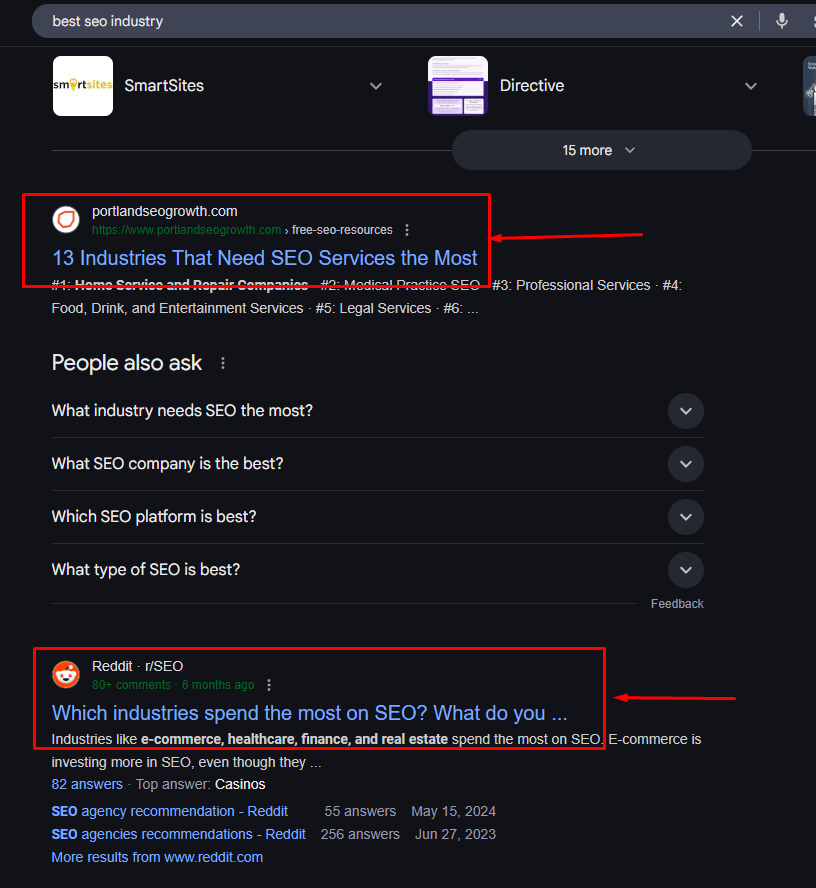
So, free traffic basically means people are coming to your website without you having to pay for every click. You’re not buying ads here. Instead, you’re earning attention by creating good stuff—blogs, videos, posts, emails, all that.
It’s called “free,” but let’s be real—it’s not 100% free. You might not be spending money per click, but you are spending time, effort, or maybe money to get good content created.
But the good part? Once that content is live, it can keep bringing people in for months, even years, without paying again.
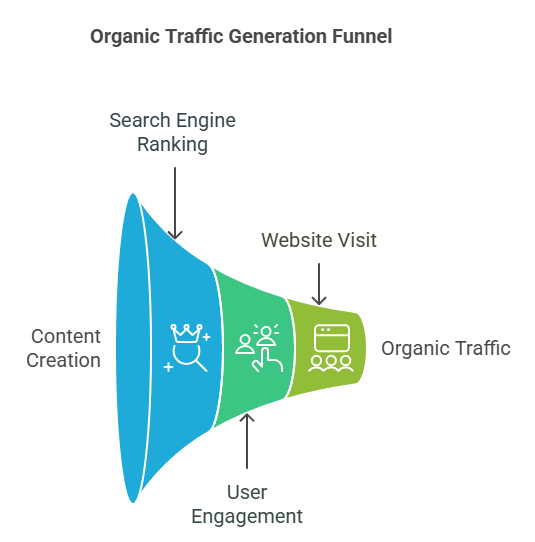
Where Does Free Traffic Come From in 2025?
Let me give you a few powerful sources that are crushing it right now:
1. Google SEO
This is the big one. You write content (like a blog post) that shows up on page 1 when someone searches. You don’t pay for clicks. If it ranks well, it keeps bringing in visitors every single day.
2. YouTube Videos
Make videos that teach or entertain. YouTube is a massive search engine now—great for long-term traffic if your video answers a real question.
3. Pinterest
Still a gem in 2025, especially for niches like recipes, fashion, beauty, travel, and DIY. Pins last way longer than Instagram posts and can send regular traffic for months.
4. Email Newsletters
This one’s gold. You build a list over time, and then you can email people whenever you want—no extra cost. Best part? These are warm leads. They already know you.
5. LinkedIn Posts & Articles
This one’s huge for B2B and personal brands. Write useful stuff. Share insights. Tell stories. You can grow an audience and drive real business just by showing up consistently.
6. Reddit
Reddit is a solid free traffic source if used right. Share helpful answers in relevant subreddits without being spammy. When done well, it builds trust and sends curious users straight to your site.
7. Word-of-Mouth (Direct Traffic)
Now this one’s a bit underrated, but super powerful. You know when someone tells a friend, “Hey, check out this awesome website,” and then that person types your URL directly into their browser? That’s word-of-mouth traffic. It means people trust you enough to recommend your site to others.
8. Backlinks from Other Websites
This is another big one in the SEO world. When another trustworthy site links to your content, it’s like a thumbs-up in Google’s eyes. And not only does it help boost your rankings, but people actually click those links and land on your site. So it’s a double win—more authority and more visitors, all without paying per click.
If you want to learn how to create profile backlinks for a new website in 2025, you can visit this guide.
Why Free Traffic is Awesome
Now, let me tell you why I love free traffic (and recommend it to almost every client):
✅Long-Term ROI
Let’s say you write one great blog post. It takes you a few hours. Maybe even a day. But once it ranks on Google, it keeps sending visitors without you doing anything extra. I’ve had posts still driving traffic 2–3 years later.
✅It Builds Real Trust
People are more likely to trust a blog post or video they found organically than a random ad. It feels natural. It doesn’t interrupt their experience.
✅It Works Around the Clock
Whether you’re sleeping, on vacation, or working on something else, your content keeps doing the work. That’s the beauty of it. Unlike ads, which stop the moment your budget runs out, free traffic keeps coming in as long as the content is live and helpful.
Cons of Organic Traffic
Now, let me tell you what the downsides of organic or free traffic are:
❌It’s Slow to Build
If you’re hoping for quick results, organic traffic might test your patience. SEO takes time—sometimes months, and in competitive niches, even a year or more.
You write a great blog post today, but it might not rank until weeks later. That’s just how the game works. Google wants to trust your site before giving you top spots.
❌You’re at the Mercy of Algorithms
Now this one’s a biggie. Google changes its algorithm all the time. Sometimes small tweaks, sometimes big shakeups. One day your blog is ranking #1, the next day it's on page 3.
So even if you're doing everything right, those updates can hit hard. You’ve got to stay on your toes and adapt constantly.
❌It Needs Ongoing Work
Organic traffic isn’t a one-and-done deal. You can’t just publish a few articles and expect traffic forever. You need to keep updating content, doing keyword research, optimizing for speed, checking your on-page SEO—the whole thing. Plus, there’s always someone trying to outrank you, so it’s a bit of a battle.
Real Data in 2025
Here are a few statistics about Organic traffic in general.
- In 2025, over half of all website traffic (53%) will come from Google search, so SEO is a must.
- 61% of people use their phones to search, so your site must be mobile-friendly.
- Businesses that focus on content marketing get 6 times more leads—case studies work best for B2B.
- AI and machine learning are changing SEO—Google’s AI Overviews (from May 2024) show new-style search results.
- By 2026, voice search, visual content, and AI-made personalized content will be the top trends for growing free traffic.
Paid Traffic vs Free Traffic: Conversion Comparison
Businesses can make better choices about their marketing strategies by looking at key stats from the organic vs paid search chart here.

So, in 2025, organic search still leads, driving 53.3% of web traffic, and users trust it more than paid ads. While paid search conversion rates are slightly higher at around 4.8%, 65%-70% of users trust organic results more. Mobile traffic is massive for both, with 70% of paid clicks happening on mobile, but organic traffic offers more long-term, cost-effective growth.
- Paid traffic converts faster, especially if your ad copy is strong.
- But free traffic from SEO can convert really well too, especially if your content solves a real problem.
- Email traffic often converts best, but only if you already have a solid list.
What About Cost?
Let’s look at Cost Per Acquisition (CPA)—how much it costs to get customers.
Traffic Source | Avg. CPA in 2025 |
|---|---|
Google Ads | $48.96 |
Facebook Ads | $18.68 |
TikTok Ads | Around $1.00 per click |
SEO Content | $0 (but you pay to write/create it) |
Almost $0 after setup |
Note: SEO is not completely free—you need time or someone to write quality content.
You can learn more about calculating costs with tools like our free CPA Calculator (Cost Per Acquisition) to better understand your marketing performance.
How People Engage
Here’s what I see a lot in analytics:
- Paid visitors usually act fast but bounce quickly if they don’t like what they see.
- Free visitors stay longer, read more, and often come back.
- SEO traffic gives better engagement and longer session times.
When Should You Use Paid Traffic?
Choose paid traffic when:
- You're launching something new
- You want results now
- You’re testing what works
- You have a decent budget
Paid traffic is perfect for fast growth, product launches, and short-term campaigns.
When Should You Focus on Free Traffic?
Choose free traffic when:
- You want long-term brand growth
- You’re building trust and authority
- You have a small or tight budget
- You want ongoing traffic without paying again and again
Free traffic is like planting seeds—it takes time, but it grows and grows.
Best Strategy? Use Both Together!
Here’s what I do (and what works best):
Step-by-step Combo Strategy:
- Run paid ads to test what headlines or products work.
- See which pages or keywords are converting.
- Create SEO content based on that.
- Use retargeting ads to bring organic visitors back later.
- This mix brings fast wins + long-term growth.
Actionable Tips for 2025
Here are a few things I always recommend:
- Use Google Analytics 4 and Hotjar to track traffic and behavior.
- Invest in SEO tools like Ahrefs, Semrush, or Surfer SEO.
- Write for humans first, then optimize for Google.
- Test ads on TikTok and YouTube Shorts—they’re working well in 2025.
- Build your email list early—it pays off over time.
Wrapping Up: Which One Works Better Between Paid Traffic vs Free Traffic?
- If you’re new: Start small with paid traffic to test and learn. Then build your SEO around what works.
- If you’re experienced: Combine both. Paid traffic gives control, SEO gives stability.
Remember: Paid traffic is fast, but SEO is forever.
Hope this blog helped you see the full picture. If you’re still unsure, feel free to reach out or comment below with your situation—I’ll be happy to guide you!
Frequently Asked Questions
Tech blogs, SaaS companies, and e-commerce sites all benefit from organic traffic. Tech blogs earn more through affiliate links, SaaS companies build authority with content, and e-commerce sites attract buyers without relying on ads.
E-commerce stores can boost sales during events like Black Friday, local businesses attract nearby customers with special offers, and startups get quick traction with PPC campaigns like Google or Facebook ads.
Organic search is cheaper because it doesn't require ongoing payments like paid search. It takes time to see results, but it gives long-term benefits with a solid SEO strategy.
You can track ROI by looking at how your rankings, website traffic, and conversions change after improving your SEO. Compare the revenue from those conversions to the cost of your SEO efforts.
Negative keywords help filter out unwanted search terms so your ads don’t appear in irrelevant searches. This ensures your ads are shown to the right people.
Paid search ads don’t directly affect organic rankings, but they can bring more traffic and brand awareness, which might help organic growth over time.
Focus on using the right keywords, making your site load faster, and creating high-quality content. Also, build backlinks and improve user experience to help boost rankings.
You can stop paid search when organic rankings improve, but it's not always a great idea. Paid ads bring quick visibility, while organic growth takes longer to fully replace it.
Organic search is great for long-term results, while paid search gives instant visibility. Combining both often works best to drive traffic and leads.


